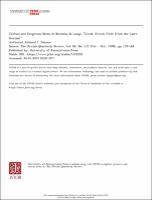Please use this identifier to cite or link to this item:
https://hdl.handle.net/20.500.12202/4314Full metadata record
| DC Field | Value | Language |
|---|---|---|
| dc.contributor.author | Steiner, Richard C | - |
| dc.date.accessioned | 2019-01-30T21:06:23Z | - |
| dc.date.available | 2019-01-30T21:06:23Z | - |
| dc.date.issued | 2007-01 | - |
| dc.identifier.issn | 0022-2968 | - |
| dc.identifier.uri | https://yulib002.mc.yu.edu/login?url=https://doi.org/10.1086/512212 | en_US |
| dc.identifier.uri | https://hdl.handle.net/20.500.12202/4314 | - |
| dc.description.abstract | The Judeo-Arabic commentaries of R. Saadia Gaon (882–942) and his successors contain a number of exegetical terms that were used earlier by quranic exegetes, for example, haqiqah wa-majaz “expressions that are literally true and expressions used with literary license,” muhkam wa-mutasabih “univocal and ambiguous,” and muqaddam wamu ªahhar “hysteron proteron.”1 Some of these terms also have Hebrew analogs. Hebrew has an opposition between ªemet and masal (lit., “truth” and “parable”) that is rare in the Talmud but becomes more prominent in the Islamic period as an equivalent of the haqiqahmajaz dichotomy.2 Hebrew also has a term muqdam u-meªuhar that, like Arabic muqaddam wa-muªahhar, refers to inverted order. M. Zucker has argued that the Hebrew term is a borrowing of the Arabic one: “The use of this exegetical principle is found already in tannaitic and amoraic literature, but their term is serus. . . . The term min ha-muqdam weha- meªuhar is found only in sources of the Arabic period. . . .” | en_US |
| dc.language.iso | en_US | en_US |
| dc.publisher | University of Chicago Press | en_US |
| dc.relation.ispartofseries | Journal of Near Eastern Studies;66(1) | - |
| dc.rights | Attribution-NonCommercial-NoDerivs 3.0 United States | * |
| dc.rights.uri | http://creativecommons.org/licenses/by-nc-nd/3.0/us/ | * |
| dc.subject | muqdam u-me'uhar | en_US |
| dc.subject | muqaddam wa-mu'ahhar | en_US |
| dc.subject | Hebrew and Aramaic terms | en_US |
| dc.subject | Hysteron Proteron | en_US |
| dc.subject | Anastrophe | en_US |
| dc.subject | Quranic exegetes | en_US |
| dc.title | Muqdam u-Meʿuḥar and Muqaddam wa-Muʿaḫḫar: On the History of Some Hebrew and Arabic Terms for Hysteron Proteron and Anastrophe. | en_US |
| dc.type | Article | en_US |
| local.yu.facultypage | https://www.yu.edu/faculty/pages/steiner-richard | |
| Appears in Collections: | Bernard Revel Graduate School of Jewish Studies (BRGS): Faculty Publications | |
Files in This Item:
| File | Description | Size | Format | |
|---|---|---|---|---|
| Steiner Textual JQR PubVers 1998 1455293.pdf | JNES Pub Green | 706.91 kB | Adobe PDF |  View/Open |
| Steiner Textual JQR PubVers 1998 1455293.pdf | JNES GreenPDF | 706.91 kB | Adobe PDF |  View/Open |
This item is licensed under a Creative Commons License

